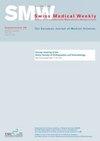多化疗和干扰素治疗后长期存活的转移性黑色素瘤的特征:一项回顾性研究
IF 2.1
4区 医学
Q2 MEDICINE, GENERAL & INTERNAL
引用次数: 0
摘要
背景:免疫疗法和酪氨酸激酶抑制剂的开发极大地改善了转移性黑色素瘤的预后。因此,化疗现在已很少使用。在此,我们描述了接受免疫化疗后长期存活的转移性黑色素瘤患者的特征。材料与方法:我们检索了1993年1月至2015年12月期间确诊的转移性黑色素瘤患者的回顾性临床和病理数据,这些患者在日内瓦大学医院接受了CVD-INF(顺铂、长春新碱、达卡巴嗪和干扰素α-2b)方案治疗。我们估算了他们的无进展生存期和总生存期。这项特别研究的主要目的是描述长期存活者的临床和生物学特征,长期存活者是指免疫化疗开始后存活两年以上的患者。通过免疫组织化学方法确定 CD8+ T 细胞的空间分布模式(炎症、排除或荒漠)。结果:90名患者接受了CVD-INF治疗。他们确诊为转移性黑色素瘤时的中位年龄为 55 岁(20-75 岁)。他们的中位无进展生存期为 2.8 个月,中位总生存期为 7.2 个月。11名患者(12%)长期存活。在多变量分析中,中枢神经系统转移(危险比 [HR]:2.66;95% 置信区间 [CI]:1.43-4.95;P = 0.001)、多发转移(HR:1.82;95% CI:1.01-3.29;P = 0.047)和乳酸脱氢酶(LDH)升高(HR:1.92;95% CI:1.12-3.30;P = 0.016)与较短的生存期独立相关。大多数长期存活者(6/8;75%)具有肿瘤发炎模式,而 25% 的非长期存活者(5/20;费雪检验 p = 0.030)具有肿瘤发炎模式。结论:一部分接受CVD-INF治疗的肿瘤炎症表型转移性黑色素瘤患者存活时间超过两年。延长生存期的相关因素与之前报道的转移性黑色素瘤的相关因素一致。本文章由计算机程序翻译,如有差异,请以英文原文为准。
Characteristics of long-survivor metastatic melanoma after polychemotherapy and interferon: a retrospective study
BACKGROUND: The development of immunotherapy and tyrosine kinase inhibitors dramatically improved the prognosis of metastatic melanoma. Consequently, chemotherapy is now rarely used. Here, we describe the characteristics of long-surviving patients with metastatic melanoma treated with immunochemotherapy. MATERIAL AND METHODS: We retrieved retrospective clinical and pathological data for patients diagnosed with metastatic melanoma between January 1993 and December 2015 who received the CVD-INF (cisplatin, vinblastine, dacarbazine, and interferon α-2b) regimen at the Hôpitaux Universitaires de Genève. We estimated their progression-free survival and overall survival. This ad hoc study’s primary aim was to describe the clinical and biological characteristics of long-term survivors, defined as patients surviving more than two years after immunochemotherapy initiation. The spatial distribution pattern of CD8+ T cells (inflamed, excluded, or desert) was immunohistochemically determined. RESULTS: Ninety patients received CVD-INF. Their median age at metastatic melanoma diagnosis was 55 years (20–75). Their median progression-free survival was 2.8 months, and median overall survival was 7.2 months. Eleven (12%) patients were long-term survivors. In multivariate analysis, central nervous system metastases (hazard ratio [HR]: 2.66; 95% confidence interval [CI]: 1.43–4.95; p = 0.001), multiple metastases (HR: 1.82; 95% CI: 1.01–3.29; p = 0.047), and elevated lactate dehydrogenase (LDH) (HR: 1.92; 95% CI: 1.12–3.30; p = 0.016) were independently associated with shorter survival. Most long-survivors (6/8; 75%) had a tumour-inflamed pattern compared to 25% of non-long survivors (5/20; Fisher’s test p = 0.030). CONCLUSIONS: A subset of patients with metastatic melanoma and a tumour-inflamed phenotype treated with CVD-INF survived over two years. Factors associated with prolonged survival are consistent with those previously reported in metastatic melanoma.
求助全文
通过发布文献求助,成功后即可免费获取论文全文。
去求助
来源期刊

Swiss medical weekly
医学-医学:内科
CiteScore
5.00
自引率
0.00%
发文量
0
审稿时长
3-8 weeks
期刊介绍:
The Swiss Medical Weekly accepts for consideration original and review articles from all fields of medicine. The quality of SMW publications is guaranteed by a consistent policy of rigorous single-blind peer review. All editorial decisions are made by research-active academics.
 求助内容:
求助内容: 应助结果提醒方式:
应助结果提醒方式:


